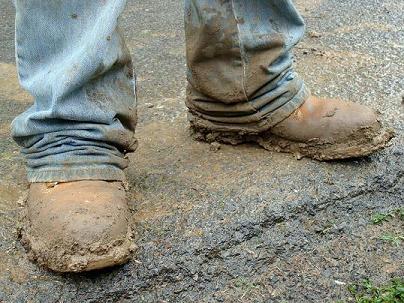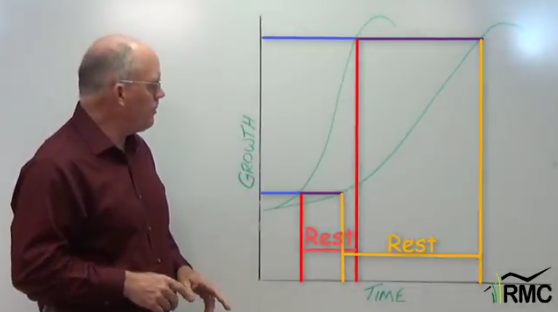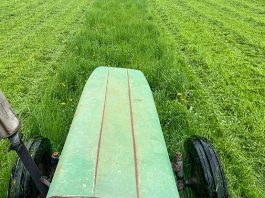 I usually appreciate rain when we get it, but too often we don’t get it when we need it. I really prefer that precipitation doesn’t get too heavy in the winter because whether it comes in the form of rain or snow, it increases work load. The solid form might look pretty, but it certainly makes driving interesting sometimes. If it is not in the form of snow, then it’s usually worse, especially when the ground is not frozen! This is one of those years so far where I’d appreciate a little bit more “free concrete” as in frozen ground.
I usually appreciate rain when we get it, but too often we don’t get it when we need it. I really prefer that precipitation doesn’t get too heavy in the winter because whether it comes in the form of rain or snow, it increases work load. The solid form might look pretty, but it certainly makes driving interesting sometimes. If it is not in the form of snow, then it’s usually worse, especially when the ground is not frozen! This is one of those years so far where I’d appreciate a little bit more “free concrete” as in frozen ground.
If you are not on heavy stockpile then you are most likely fighting mud. I’ve probably spent too much time walking fields, especially when it is raining. It’s not the most enjoyable thing to do in the winter time, especially in a cold rain, but it is educational. I would encourage every landowner to take a walk in the rain to see what is going on in your fields. I don’t blame you if you want to wait until a warm day, but walk and see what the rain is doing. Is it disappearing into the forage and soil or is it flowing across land? If it is flowing, then where is it going? Is there a lot of overland flow or runoff?

The amount of residue and/or forage residual left behind and how it stands makes an impact on runoff. The more retardance, something that breaks impact and slows movement, the less runoff. The more retardance, the more likely the increased intake or infiltration of water, unless the ground is frozen or compacted. Tightly grazed or overgrazed pastures have little retardance, so they also have increased runoff. Sadly, this also means poor plant stands, poor roots, and almost always, compaction. Lack of residue, live plants and roots with compacted layers restricting natural soil drainage are usually some of the muddiest areas under wet winter conditions. The combination usually means major pugging and mud.
Compaction is usually the primary reason that water doesn’t move downward through the profile correctly. Compaction changes the structural characteristics and functionality of the soil. When soil aggregates are pressed together, the pore spaces between them is reduced. The ability of the soil to hold and store water for later on is greatly reduced because of that lost pore space. Because the water cannot infiltrate efficiently, we have increased runoff even with good vegetative retardance. On a larger scale, the water speeding downhill in the watershed fills up dry dams, ponds, streams and other waterbodies and causes water quality issues. How well water infiltrates the soil has a major impact on flooding.

We can limit compaction or reduce its impact by minimizing grazing and vehicular traffic under excessively wet conditions, maintaining good vegetative stop grazing heights, maintaining good live vegetative cover, and maintaining or increasing the organic matter over time by allowing adequate rest between grazing periods, which allows for more root growth. Increased root growth and turnover is key to increasing soil organic matter. A one percent increase in organic matter in the soil can increase the water holding capacity of that soil to the tune of about 14,000 gallons of water.
The soil is a water reservoir for plant growth. This time of year it doesn’t seem to be that important. But the more water holding capacity a soil has, the more resilience it has to droughty conditions or perhaps better said, “lack of rainfall” conditions. We don’t have a lot of control of when it rains or how much we get, but we can influence how much water infiltrates in the soil and is stored there by changing how we manage. Now, where was I? Oh yes, we were talking about mud.
If you have figured out a way to completely eliminate mud, I’d like to talk to you! We can certainly reduce it with the use of rock or concrete pads around feeding, watering facilities and other high traffic areas. We can also limit it to only one sacrifice area for the winter which is generally enough of an area to deal with. Areas that are torn up under wet winter conditions will usually have poor forage production the next year and are subject to invasion of weeds that love disturbance, high nutrients and organic matter. These fields often require establishment of new forage to be productive again. This forage could be perennial forage or perhaps annuals, especially if you know the area most likely will be disturbed again the next winter. Either way, going into winter with a heavy amount of forage material present on these fields is always better than a field lacking sufficient cover.
I’ve known a couple guys who have used this planting occasion as an opportunity to slowly establish new vegetation around the farm. It opens up the opportunity to kill any remaining forage present, plant an annual for summer vegetation, and then seed the area down in late summer to re-establish it to better forage.

Okay, back to that walk in the rain. What are you seeing? If you are seeing a lot of water runoff, then follow this water, when it starts concentrating as it builds flow, you will most likely find that it is causing some erosion. Small rills eventually become ephemeral gullies which eventually become classic gullies. It is almost always first an infiltration problem, then increased runoff and the start of problems that take a lot more money to fix. This is pretty much true with all land uses, especially pasture and cropland.
It really is fairly simple. When stop-grazing heights are safeguarded, even in the winter, you will have more roots and deeper roots; you are maintaining cover with that vegetative layer that helps to keep the soil covered and protected; and with that comes increased infiltration and less runoff. The increased number of deeper roots helps to increase organic matter over time and slowly break up dense soils and also helps rebuild soil structure and natural drainage in some soils. The average stop-grazing height to strive for is four inches; not the tallest vegetation left, but the shortest! This management can increase productivity and more importantly, provide resilience when the rains don’t pass our way…and protect it when they do.
This probably sounds like another soap box lecture on maintaining cover and stop grazing heights. Well, I guess it is. When we maintain residual and stop grazing heights, we fix, or better yet, greatly reduce or eliminate a lot of resource concerns. Live plants and live roots help reduce compaction and increase infiltration and reduce runoff, even under wet conditions. The more you have present the more you provide valuable protection for the soil. Heavier amounts of plant residual and residue also help armor the soil, reducing pugging, compaction, and mud during the non-growing season.
Keep warm and keep on grazing!





I have a question about this sentence: “A one percent increase in organic matter in the soil can increase the water holding capacity of that soil to the tune of about 14,000 gallons of water.” Is this per acre? Could you send me the research on this, please? (Question asked from the viewpoint of a sympathetic reader, not at all critical.)
A comment about “Areas that are torn up under wet winter conditions will usually have poor forage production the next year and are subject to invasion of weeds that love disturbance, high nutrients and organic matter. These fields often require establishment of new forage to be productive again.” I make it a practice to topseed all pugged or heavily-trodden areas on my small farm with red clover, low-coumarin yellow sweet clover, and a little orchard grass. It works on the sacrifice fields, too. If trefoil is desired, “fling it on”; my goal is no bare spots in the field.
cg
Comments are closed.